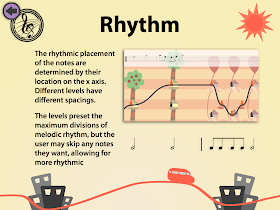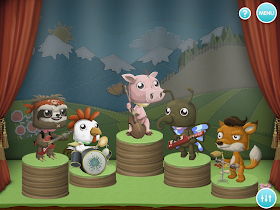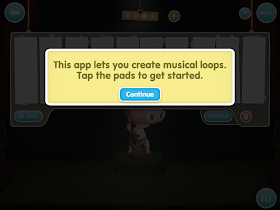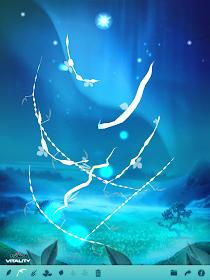There are so many great app lists out there for music education. The problem I found is that they don't always have reviews attached to them. I decided to download as many apps as I could find and test them all out. Here's what I found when it came to composing apps!
The Good
Tune Train
Pros: Easy to use, built using music theory concepts, students can see their composition on a staff, several accompaniment options for student compositions
Cons: No way to export/save the music that is created, no option to change the instrument that plays the melody
Cost: FREE
Apple: https://itunes.apple.com/us/app/tunetrain/id702713073?mt=8
Android: n/a
Tune Train is probably the most musically intuitive app I found. It was clearly designed with the music teacher in mind. Students guide a train to different stops. The train stops represent various musical ideas such as high/low(pitch) ad close together/far apart(rhythm).
There is an option for students to view their composition written out on a staff. While the compositions cannot be exported, students can easily take a screenshot of their Tune Train composition to use in another activity such as playing the melody on Orff instruments.
 One final thing I really love about this app is that you can choose a style of accompaniment. Each level has a few different options to choose from.
One final thing I really love about this app is that you can choose a style of accompaniment. Each level has a few different options to choose from.
The Lego Movie Music Maker
Pros: Characters that students like and recognize, variety of instruments for composing, save and share option
Cons: Lego loops don't always mesh well with base songs
Cost: FREE
Website: http://appcloud.warnerbros.com/lego/legomusicmaker/
This app works well in a browser on iPads. Students choose a song "base," such as the "Everything is Awesome" song, and then add their composition on top of it. Colored lego pieces each have their own sound loop ranging from percussion to vocal exclamations. Legos can be placed on and off the beat. This app is basically a simplified version of Garageband.
SketchASong
Pros: cross curricular with art, real instrument sounds, wide variety of instruments to choose from, music concepts such as chord progressions and beat placement are apparent
Cons: if students "color" the pictures, it tends to sound like a cacophony of sound rather than a piece of music, no option to export song - only to save in the app
Cost: FREE
This app combines the world of art and music. Students can choose from several coloring pages to color in. Each color represents an instrument family (ex - various shades of green are woodwinds). It might be a good app to use when teaching instrument families. All sounds in the app are recordings of real instruments.
Glitchamphone
Pros: ability to add multiple measures to create a longer piece of music, shows 4/4 beat pattern, options to adjust tempo and sound levels, includes mode to compose using a grid/colors and mode to create/record own patterns
Cons: limited amount of instrument choices, the app takes a little exploration to access all of the fun features - may not be suitable for younger students
Cost: $1.99
Apple: https://itunes.apple.com/us/app/glitchamaphone-music-making/id555790025?mt=8
Android: n/a
This app would be good to use in conjunction with a lesson on the recording industry. Students can record and fine tune their own music on a grid, similar to recording and editing MIDI sounds. This app includes a handy tutorial built into it that will help students find all of the app features.
The Bad
Monkey Drum
Pros: world music instruments available for composition, all paid options can be "purchased" through enough earning coins, control over musical ideas such as tempo and pitch, option for free play on instruments
Cons: no easy way to delete/erase a composition once you create it, only 3 free instruments, no way to export compositions
Cost: FREE with in app purchases available
Apple: https://itunes.apple.com/us/app/monkey-drum/id483225765?mt=8
Android: n/a
In the composition component of this app, students can fill in blocks representing either different pitches or timbres.The only reason why I put this under the bad category is because once a composition is finished, there is no way to start over again from scratch. If students wanted to start a new composition, they would have to uncheck all of the filled in white boxes, which is simply not practical to use as a composition app in the classroom.
The Fun But Not So Educational
Soundrop
Pros: easy to use
Cons: does not include option to save composition unless you pay to upgrade to PRO, only one instrument sound available for free, does not have any true educational concepts
Cost: FREE with option to upgrade to PRO
Apple: https://itunes.apple.com/us/app/soundrop/id364871590?mt=8
Android: n/a
This app allows you to compose by drawing lines, which play marimba pitches each time a ball hits a line. The user does not have much control over anything but the lines in the free version.
Falling Stars
Pros: options for multiple timbres through different leaf patterns, option to save and share, more control than Soundrop
Cons: not particularly educational, ads for Trident Vitality are present
Cost: FREE
Apple: https://itunes.apple.com/us/app/falling-stars-by-trident-vitality/id439921044?mt=8
Android: https://play.google.com/store/apps/details?id=com.bobisoft.wallpaper.fallingstars&hl=en
This app may be good for pre-k and k students to use to explore and create sound. You compose by drawing vines. Each vine has a particular timbre that plays when a falling star hits it. While this app is definitely not bad, there are other app options with more musical concepts built in.

 One final thing I really love about this app is that you can choose a style of accompaniment. Each level has a few different options to choose from.
One final thing I really love about this app is that you can choose a style of accompaniment. Each level has a few different options to choose from.



















Thankyou! This is really helpful :)
ReplyDelete